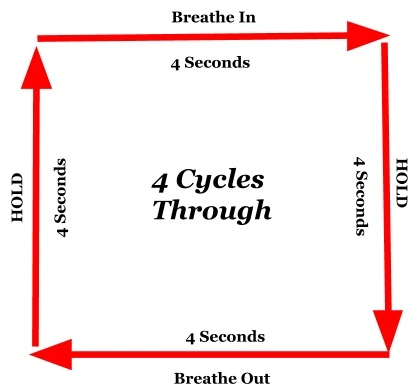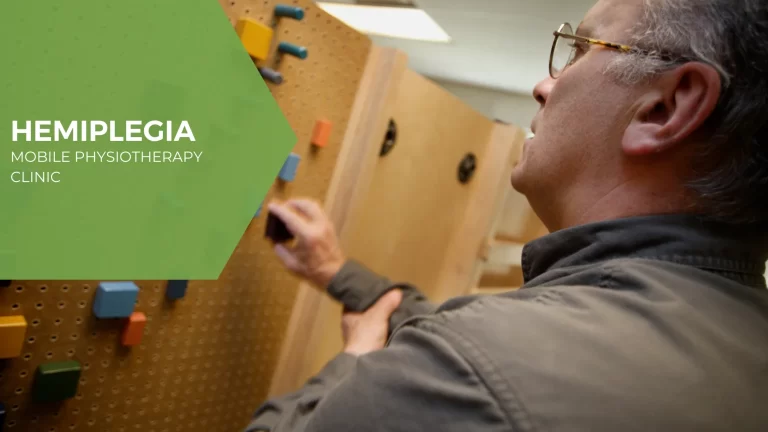Box Breathing Exercise
Table of Contents
Introduction
Box breathing is a quick and effective relaxation method that can assist in restoring a peaceful rhythm to your breathing. Your attention will increase as your thoughts will be quiet and clear.
A deep breathing method that might help you slow down your breathing is box breathing, also known as square breathing. As you count to four, your attention is diverted, your nervous system is calmed, and your body’s level of tension is reduced.
Box breathing aids in reestablishing regular breathing after stressful situations. It can support clear the mind, relax the body, and enhance attention.
Box breathing consists of four basic steps, each lasting 4 seconds:
- breath in
- hold your breath
- breath out
- hold your breath
Box breathing, also known as re-breathing or four-square breathing, is easy to do, quick to learn, and can be very useful in stressful situations.
People with high-stress jobs, such as soldiers and police, often use CPR when their bodies are in a fight-or-flight state.
What is Box Breathing?
Box breathing, often known as square breathing, is a deep, progressive breathing technique. This is also called quadrant breathing. This technique is also suitable for anyone who wants to concentrate or improve concentration.
This technique can benefit anyone, especially those looking to meditate or reduce stress. You may find it particularly useful if you have a lung condition such as chronic obstructive pulmonary disease (COPD).
How to do Box Breathing?
Don’t put too much pressure on yourself to master box breathing in no time.
- Exhale gradually releasing all the air from your lungs.
- Inhale through your nose as you slowly count with four feet in your head. Pay attention to how the air fills your lungs and abdomen.
- Hold your breath till a count of four seconds
- Exhale and count four more.
- Repeat 3 or 4 rounds.
Benefits of Box Breathing
There is enough data to suggest that deliberate deep breathing can calm and modulate the autonomic nervous system (“ANS”).
This method regulates involuntary bodily functions such as temperature. It can lower blood pressure and bring about an almost immediate feeling of calm. Slow breathing permits CO2 to build up in the blood. This creates a sense of calm and relaxation in the mind and body.
Box breathing can relieve stress and improve your mood. This creates it an exceptional therapy for diseases such as Generalized Anxiety Disorder (GAD), Panic Disorder, Post-Traumatic Stress Disorder (PTSD), and Depression. It can also support treating insomnia by permitting you to calm your nervous system at night before bed. Box breathing may even be effective in helping to control pain.
Tips for beginners
If you are new to box breathing, it can be not easy to get used to. You may feel stressed after a few rounds. It’s normal. As you practice it more frequently, you can go longer without getting stressed. If you feel dizzy, sit still for a minute and continue breathing normally.
To help you focus on your breath, find a quiet, low-light atmosphere to practice box breathing. It’s unnecessary to perform this technique at all, but it can help you focus on your practice if you’re new to it.
Box breathing tips
- Find a quiet space to start breathing
- Placing one hand on the chest and another on the lower abdomen can help
- Try to feel the air and see where it goes by breathing in.
- Focus on feeling the stomach swell, but don’t squeeze the pushing muscles
- The box breathing cycle should ideally be repeated four times.
Why is breathing important for health?
adjusting the breath, or working to bring the breath out of fight or flight mode, is great for the mind and body.
The autonomic nerve system, sometimes known as the unconscious body, is responsible for bodily processes like digestion and heartbeat that happen without conscious thought.
In fight or flight mode, the body feels threatened and reacts to aid the person’s flight or avoid a threatening situation. The body, among other things, releases chemicals like adrenaline and noradrenaline. These trigger a range of responses, including increased heart rate, increased breathing rate, and increased blood sugar.
Staying in this state of stress for too long or too often will have adverse health consequences. The physical impact of this condition can cause wear and tear on all body systems.
Long-term stress can increase your risk of:
- High Blood Pressure
- headache
- Heart attack
- stroke
The capacity to intentionally regulate breathing allows the body to leave a state of tension and enter a state of calm.
Do box breathing multiple times a day as needed to calm nerves and reduce stress.
- Lowers stress
The most significant advantage of box breathing is relaxation, especially during stressful periods. Studies show that controlling your breathing can lower levels of the stress hormones cortisol, and may even help lower blood pressure.
- Activation of the parasympathetic nervous system
During times of anxiety, your sympathetic nervous system is on high attention. Canned breathing activates the parasympathetic nervous system, which controls rest and digestion, opposing the fight-or-flight response.
- Calm the mind
This breathing technique does not need you to be uptight. Even in quiet moments, box breathing allows you to bring attention to your breathing, which is an important practice.
“It allows you to slow down your breathing, and it also has a meditative aspect,” the Therapist explains,””You count in silence as you breathe,” explains the author, “which is a type of mantra meditation that relaxes your nervous system and brings you into the present moment.”
How to practice Box Breathing?
Box breathing involves four simple steps.
The goal of the exercise is to imagine a box with four equal sides. You can do this with your eyes closed or with a calm expression on your face.
Assume you are following or tracing one side of the box in the particular step. Start at the top corner and work your way around the box until you back to the beginning.
Inhale slowly through your nose on a count of four after reaching the top of the box.
Walk to one side of the box and hold your breath for four counts. Exhale gently while counting to four, releasing all of the air from your lungs.
Hold your breath for a count while you climb to the opposite side of the box.
Summary
Box breathing is simple to master and requires only four stages. It might bring more awareness and calmness into a person’s daily routine.
Box breathing is one of many breathing techniques that can help in stress reduction. Studies suggest that this and other techniques can deliver both immediate and long-term advantages.
Although additional study is required, current studies provide strong support for box breathing as an effective tool for stress management, restoring attention, and boosting pleasant emotions and state of mind.
FAQs
According to research, controlled, deep breathing has various benefits for the body and mind. Box breathing is one such deep-breathing practice. This easy four-step technique not only relieves tension, but may also aid in the treatment of anxiety, depression, and pain.
Box breathing, often known as “the Navy SEAL breathing technique,” is used by highly qualified military officers to steel their nerves and focus before entering high-pressure situations. Professional participants, police officers, and nurses all share this view.
This process can be beneficial to anyone, particularly those who want to meditate or reduce stress. It’s used by everyone from athletes to police officers and nurses. You may find it especially useful if you have a lung disease such as chronic obstructive pulmonary disease (COPD).
When anxiety comes, practicing box breathing during calm periods might help make this technique easier and more familiar. Some people may benefit from visualizing a real box. This makes switching from one nervous thought to another difficult and functions as a breathing technique.
Box breathing is easy and quick to learn. Anyone can practice this technique and it’s useful in stressful situations when you want to re-center yourself or improve your concentration.








One Comment